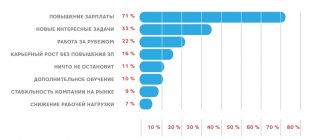Adaptation goals:
- Cost reduction - the faster an employee integrates into the work environment, the faster he will work effectively.
- Reduce employee turnover: If a new employee feels uncomfortable in the workplace, he may start looking for a new job. If adaptation is successful, the new employee quickly joins the team and the chance that he will stay in the company for at least three years increases by 69%.
- Saving time for the immediate manager: adaptation according to a specific algorithm helps different departments of the organization interact better to immerse the newcomer in the work environment.
- Reducing the stress level of a new employee.
- Increasing employee job satisfaction.
Rules for the first working week
In the first 3 months, the manager, HR and the employee himself must put in a lot of effort. The newcomer is worried that expectations from the place of work may not coincide with reality. The more insecure a person feels, the more difficult it is to work.
To help integrate into the company, the boss should support the employee. The first week is the most important for adaptation.
Introduce the employee to the team personally. Send out an email so that those who missed the new person can find out about him. Mention the newcomer's previous experience and responsibilities. Introduce the employee to clients, if necessary. Make the first day an easy version of a normal work day.
Tell us about the products and customers, show the organizational structure of the company, explain which colleagues are responsible for what.
Outline the employee's area of responsibility and your expectations. Explain how tasks are set in the organization and their implementation is monitored. Give some tasks for the current week.
Familiarize the newcomer with the team rules, work schedule, corporate traditions, team building, vacation and lunch schedules.
Tell us in which areas you are ready to provide support. If you see that a person does not share his difficulties, ask a recruiter for help.
What influences adaptation?
- The company's openness to the arrival of newcomers to the team.
- Organization size: In a small organization, onboarding new employees is less formalized.
- Corporate culture – how open it is, how logically structured it is, and whether there are ready-made integration algorithms.
- The psychological climate in the team, in a friendly environment, adaptation occurs faster.
- Management skills, both from the immediate supervisor and from senior management.
- Motivation of a new employee - whether he is committed to short-term cooperation or plans to work as long as possible.
- A position with great responsibility and an impressive amount of work requires a long adjustment period.
- Personal characteristics of a newcomer - emotional intelligence, communication skills, education, qualifications.
- Compliance of skills and professional competencies with the position held.
Mikhail Pritula:
“What we call adaptation consists of 3 stages: onboarding, induction, adaptation. Onboarding is the process of introducing an employee to a company, like on an airplane. At this stage, the person is provided with primary information.
Many HR systems allow you to prepare for going back to work. You can enter your data into the system, read the employee handbook, set up mail, messenger and other tools for work.”
How to effectively train employees
8 steps
Thank you. It will be interesting!
Types of adaptation:
Adaptation can be primary , if an employee starts work for the first time in his life, and secondary , when he already has work experience. However, this division does not cover all the directions in which employees adapt to the new environment. If we consider this process in more detail, we can distinguish the following types of adaptation:
1. Social adaptation – familiarization with the “company atmosphere”, integration into the social environment, acceptance of norms of behavior, active interaction with this environment. 2. Production adaptation - inclusion of an employee in the production process, study of labor standards and production conditions, this includes getting used to new technology and software, studying a CRM system. 3. Professional adaptation – acquisition of new knowledge and skills needed in a new place of work, assessment of growth prospects, opportunities for training and advanced training. 4. Physiological adaptation – adaptation to new working conditions, schedule, loads. 5. Psychological adaptation – building relationships with the team and management. 6. Organizational adaptation - the study of interaction mechanisms in the organization: who can be contacted with this or that question, who reports to whom. Its result is a clear understanding of your place in the company structure. 7. Economic adaptation is the process of getting used to the system of material incentives and the level of payment.
Adjustment period
Adaptation to a new job takes an average of 3 months, which is how long the probationary period lasts.
This period is recommended by psychologists - in three months a person has time to get to know his colleagues and get used to the rules. Many people cannot cope with stress, and it is especially difficult for introverts. Difficulties with social adaptation lead to decreased performance, mistakes, and violations of rules.
This often leads to layoffs. Therefore, it is important to go through each period of adaptation to new responsibilities and prepare yourself mentally so as not to experience stress.
There are three phases of addiction depending on the period of work.
1. Acute.
It goes away within the first 3 months after changing jobs. Stress and adaptation to new conditions lead to uncertainty in one’s actions and indecision.
The work may not seem as serious as it seemed. Gradually, the psychological stress passes, and addiction sets in. The stage ends with the awareness of the fact that there is nothing overly complicated in the work; there is enough knowledge and experience to complete it.
2. Optimistic.
Occurs 4-6 months after employment. Psychological discomfort passes, the person begins to feel calm. Communication with colleagues improves, the director assigns him more responsible tasks. Work begins to bring joy and moral satisfaction.
3. Secondary.
Begins 6-8 months after employment. A person feels like a full member of the company, knows formal and informal rules very well, and knows how to find an approach to subordinates.
One of the main problems is how to get used to a new job without experience. In this case, the adaptation period increases.
Three approaches to adaptation
“Optical” - “you work, and we’ll look at you”
This approach cannot be called successful. Employers who choose it prefer to discuss the employee's salary and responsibilities after looking at him in action. There is practically no training; a beginner gets to work right away. If he doesn't fit, they hire someone else. For a new employee, this can result in frustration and a feeling of uselessness.
“Army” - “hard in training, easy in battle”
The probationary period becomes a real test of survival - the newcomer is given complex and responsible tasks, but is not explained how to complete them. Under these conditions, only the most purposeful remain. The employee who was not suitable is parted with and a new one is hired. This method has negative consequences: after joining the staff, the new employee relaxes or begins to “revenge”. Newcomers in such organizations are treated with hostility or tried not to notice - it is unknown how long they will last. Thus, an attempt to hire the best personnel results in the long term in a bad attitude towards work and conflicts in the team.
“Affiliate” – “we will help”
This approach is the result of an effective personnel policy. The employer realizes that there are no ideal candidates, does not delay the search, but chooses the most suitable person for the position. Entry into work is as smooth as possible - the employee is trained, introduced to the organization, and assigned a mentor so that he can ask him his questions.
Vladimir Trofimenko , General Director of the Mankiewicz representative office in Russia and the CIS countries, Member of the Strategic Council for Investments in New Industries under the Russian Ministry of Industry and Trade:
“Our project management system was implemented in a natural, organic way and was based on the desire to achieve the company’s goals. We do not have a department that could deal with personnel adaptation. Instead, a “start-up” system has been introduced. They are formed based on the psychophysiological characteristics of each participant and are based on continuous training of team leaders who monitor balance, clear planning and hierarchy within the team. With this approach, the effectiveness of an entire department is always greater than the sum of the abilities of its constituent employees. Each startup is recruited for a specific project, and its duration depends on the deadline for completing the task. As soon as one startup closes, a new one is immediately formed, with a different composition of employees. Thus, the new employee does not go through a long adaptation process, but immediately gets to work and gets to know his startup colleagues. When the task changes, the newcomer begins to delve into the specifics of the work of another startup and works with other colleagues. It is quite difficult to accept a structure where there are no instructions for staff, a percentage of sales and penalties. But the results speak for themselves: at Mankiewicz, our average employee tenure is 12 years, and there is no staff turnover that plagues Russian companies. Many stay with us after coming for an internship for the first time as students. This means that the system confirms its effectiveness.”
Stages of adaptation for a new employee
Familiarization
This usually takes place during a probationary period. The employee gets acquainted with the goals and objectives of the company, corporate culture, and team. He analyzes whether his expectations and career goals coincide with what the employer offers, and makes a conclusion whether to stay with the organization.
The employer evaluates potential capabilities and professional competencies to understand whether the employee is suitable for this position. Depending on the decision made, the personnel department prepares documents on the admission of a new employee to the staff or on dismissal.
Device
This stage lasts from a month to a year. Its duration depends on the complexity of the work, the expected level of responsibility, the assistance provided to the employee by colleagues, subordinates, management and the personnel service. Storekeepers adapt the fastest (27 days); for office managers and secretaries, this process takes 46-47 days. Sales managers, accountants and executives get used to a new place of work in 80-82 days. Programmers (102 days) and HR employees (100 days) take the longest to adapt.
Assimilation
The employee is accepted by the team and is well aware of his place in the team. Its effectiveness increases. At this stage, the employee can determine for himself which tasks are important and priority, and which are routine.
Previously, the website Job.ru (now hh.ru) conducted a survey “Who most often helps a newcomer fit into a new team faster, master new tasks” and here is the result:
Socialization
Rule one - start with yourself
On the first day in a new place, invite a person to your place and have a conversation with him . Tell us about the company, its structure, corporate culture, features of the area of work. Take him through the departments, show him where and what is located. This is clear to you as a manager and you know where the HR department is, where the accounting department is, and where the restroom is. But for the new guy, no! There is no need for him to waste time looking for the necessary office - let him better study his job responsibilities.
Rule two - introduce the new employee to the team
As a leader, you should do this too. Let us immediately warn you against a common mistake. Do not use the school format, when a new student is put at the blackboard and told to the whole class: “Meet, this is Masha, our new student.” Such an acquaintance is extremely stressful. And starting dating with stress is not the best idea. Therefore, we advise you to do differently.
At first, it is better to assign a new employee to an experienced mentor. We will return to these questions below when we talk about professional adaptation. And now the main thing is getting to know each other. Invite them both into your office and introduce them to each other. And let them go to work. Believe me: they will figure it out on their own without you. And they will become acquainted and find a common language. This is a subtle psychological point - in the presence of a boss, subordinates behave differently than without him. They feel freer and more relaxed. Therefore, acquaintance will occur in the easiest form.
Rule three - involve the new employee in the informal life of the team
So, the first acquaintance has passed, the new employee has been working in the team for some time. To consolidate the effect and speed up adaptation, we move on to the next stage. We have already written about how important informal events are for building team spirit. Corporate events, outings, sports competitions - all this contributes to the unity of employees. Therefore, immediately invite new employees to such events. And try to make them as comfortable as possible. It’s no good when a newbie stands by the wall and gets bored.
Rule four - protect people from toxic employees
At first, newcomers are happy to make any acquaintance in the team. And they can make friends with those who will not influence them very well, initially setting a negative attitude. Almost every team has those who are always whining about low salaries, incompetence of management, subjective attitude, and so on. We have already written about toxic employees - protect new employees from their influence.
As a leader, you know the team better than anyone else. Therefore, try to gently guide the new employee in his first acquaintances. Describe who is what. Like, this is Ivan Ivanov, our best employee of the month. And this is Petr Petrov, he is the first candidate for dismissal. Draw your own conclusions, dude. If a guy is smart, he will understand your subtle hints.
This should be done as gently as possible. Most likely, your words will reach everyone - employees love to chat and discuss the manager’s words over a smoke break or lunch.
Now let's move on to the more important part - professional adaptation. There are also a few rules here.
Adaptation of new employees: how to speed up
Hiring an employee is a long and complex procedure. The employee has not yet begun his duties, but financial and time resources have already been invested in him. Any employer is interested in ensuring that the adaptation of new employees takes place as quickly as possible. What you can do for this:
Develop an adaptation plan
This is a manual for the HR department and a new manager, which shows step-by-step measures to introduce the employee to the process. This can include:
- Introductory tour. This should not be neglected; often an employee is embarrassed to ask where the canteen or break room is located.
- Internal rules and regulations: work and rest hours, rules for using a mobile phone during working hours, schedule of meetings and team building events, dress code adopted by the company.
- Hiring an employee: signing an employment contract, issuing a hiring order, making an entry in the work book.
- Introducing the employee to how information is exchanged in the company: through instant messengers, email or using a CRM system, as well as issuing a login and password for corporate mail.
Any company develops, and regulations change along with it, so the plan needs to be periodically updated: remove unnecessary things and supplement with new information.
Conduct training or education
These could be events designed to train new employees or general sessions for all employees. They can be individual or group, for example, a ready-made introductory video course in a corporate training system.
Attach a mentor
It is to the mentor that the new employee can ask any questions about the organization of work, communication with other departments and other important nuances.
Establish communication with your immediate supervisor
A newbie should receive feedback from his boss. It may be worth setting aside a special time for this where you can ask all questions and get feedback on your work. It is important for a manager to pay attention to signs of maladaptation in an employee’s behavior:
- decreased performance recently;
- poor relationships with the team;
- disregard for corporate culture norms;
- violations of discipline;
- dependence on a mentor or leader;
- decreased motivation.
Include a newcomer into the life of the team
It is necessary to introduce the employee to the team, tell him what his duties will be, and what questions he can be contacted about. If the organization is large, it is better to duplicate this information in an email newsletter.
Team building events are also suitable for this. A beginner can prove himself in sports or creative projects. Not everyone is ready to immediately become actively involved in corporate life, but if a person shows initiative, we need to give him this opportunity.
Anna Leonova , employee of the personnel motivation and adaptation department of ICL Services:
“A new job is always stressful, whether you are a senior specialist or an intern. A new team, office, responsibilities or processes are all a potential risk that the newcomer will not like it and will leave for another company. That's why organizations do everything they can to minimize these risks. At ICL Services, the adaptation of new employees is worked out to the smallest detail. We understand that the less time a newcomer spends on entering a position, the faster and more efficiently he will begin to work and benefit the business. The first thing a new employee sees after HR in a company is his mentor. The mentoring program lasts 3 months and helps to socialize in a team. There is always someone nearby who can tell you: how to use the internal portal, how to apply for training, who to contact on a work issue, or where the canteen is located. ICL Services received the prestigious IT HR Awards for this program. The portal has been studied, the recruiter's kit is on the table, the equipment has been received, and now the first letter arrives in the mail. In it, the employee sees that he was expected at a new place. By the way, all colleagues also receive a newsletter with a photo of the newcomer, so that they understand which team he works for. The introductory training talks about the work of all departments of the company, social responsibility, processes and projects. Department heads and top executives come here to talk live about the company’s mission, what’s here and why. Such training is carried out as the group is recruited. To make it easier to understand the unofficial rules of behavior in open space, the company has developed a comic where it explains what is good and what is not so good. We also have an electronic adaptation course. In it, the employee sees what trainings he must undergo and what information he must study so that the work becomes clearer and easier. After the probationary period, the employee undergoes a “360” assessment, which is designed to assess his success during this period. The employee is assessed by his manager, colleagues with whom he worked, and, of course, himself. You should always remember that there are two parties involved in hiring and onboarding. And a newcomer also evaluates the company when he comes here. And if he couldn’t adapt, that’s a question for the company.”
What to do on your first day of work
The most important first day at a new job should be spent in such a way as to leave a good impression and learn new things. From the first minutes of being in the office, study your colleagues, pay attention to their communication style and behavior.
What to do on your first day of work.
- Understand job responsibilities. Read the documents that will be given to you and ask questions to management if necessary.
- Familiarize yourself with the internal work schedule: when the working day begins and ends, what time is lunch, how often can you go out for smoke breaks.
- Learn about corporate traditions. This will take more than one day; it will take a long time to get acquainted with the internal charter of the company, but you should start from the first day.
- Complete all necessary instructions: safety instructions, first aid, fire safety.
- Get a list of contacts that will be needed in your work. Find out your preferred method of contacting management.
- Take a tour of the common areas, find out where the dining room and bathroom are located.
- Get to know the employees with whom your work will be closely related.
How to survive a job change without feeling too stressed? Prepare thoroughly for the first day. Be prepared for difficulties, but guidance will help you overcome them. Immediately clarify who will help you and advise you, whether there is a mentor. Moreover, his help will not be needed constantly, but only for the period of adaptation.
Let's summarize
Onboarding should not be viewed as a process of learning a new job. It involves immersing an employee in a new environment, understanding the rules of behavior, interacting in a team, accepting corporate norms, and establishing relationships with colleagues and partners.
The adaptation process is mutual: the organization evaluates the employee, and the employee evaluates the organization. A lot of time is spent searching for a suitable specialist, especially a highly qualified one, so every employer is interested in ensuring that the employee starts working with maximum efficiency and benefit as quickly as possible.
Adaptation of new employees can go in different ways: somewhere a newcomer is thrown into the thick of things, hoping that he will figure it out on his own; somewhere they are treated with care so that the stress experienced by the employee is minimal.
It is important to understand that the duration of adaptation does not coincide with the duration of the probationary period; it can take up to four months or more. A developed adaptation plan, the assignment of a mentor, and a system of training and corporate education will help speed it up.
Rules for communicating with a young employee
In order for interaction with young employees to be constructive and bring the desired effect, the mentor needs to remember the rules of communication that must be followed.
- Don't order. The mentor must remember that a phrase containing a commitment of any kind is subject to protest. In the process of communicating with young employees, you should abandon phrases like “you must,” “you need,” “you need,” etc.
- Don't threaten. Any threat is a sign of weakness. A threat from a mentor is also a sign of failure and incompetence on the part of the mentor. Threats or an ultimatum from a mentor provoke conflict. “If you do not comply with my demands, then...” - such remarks indicate the mentor’s inability to argue his position, a lack of understanding of the situation, and a lack of necessary communication skills. This technique does not contribute to the establishment of a relationship of cooperation and mutual understanding between the mentor and the mentee.
- Make no judgments. Statements from the mentor such as “You should change your job”, “You can’t do anything” most often encounter resistance and protest from young employees, even in cases where they are absolutely fair.
- Don't make a "diagnosis". “You cannot serve in the Russian Ministry of Emergency Situations, you are too emotional” - such a phrase from a mentor will certainly alert a young employee and turn him against his mentor.











